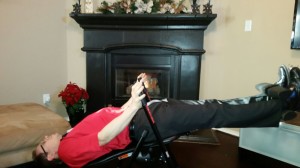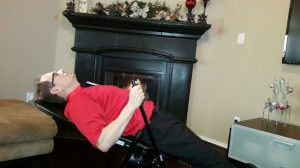Below is the short version of IF and HOW an inversion table might be a good option for you.
If you would like to learn more see the full “Will an Inversion Table Work for Me?” article I wrote at:
http://ezinearticles.com/?Will-an-Inversion-Table-Help-Me?&id=8858120
There are two bits of anatomy you should be aware of as we dive into this abbreviated version of my inversion table article.
- Between the stacked spinal bones that make up your spine are tough cartilage structures called DISCS
- The stacked spinal bones are connected to each other via JOINTS similar to how two bones in your finger would join together to create a bendable ‘knuckle joint’
The discs not only act as shock absorbers but also have the added burden of creating a space between the spinal bone above and below for the nerves that branch out from the spinal cord to all areas of the body including muscles, organs and skin.
The joints are what allow you to bend and move your upper torso.
Secondary to old injuries and micro-trauma (i.e. sitting long periods, repetitive work, bad posture, etc) the discs and joints can get compressed and degenerate prematurely over time.
The Role of the Inversion Table
While the disc has a limited blood supply and thus can not easily heal once compressed or degenerated or damaged, some studies indicate that the disc does have some nutrient supply arising from load-induced (from walking, bending, etc) fluid movement in and out of the disc.
If the disc is not getting nutrients in some way, it will be begin to break down or degrade. And as noted above, once this occurs, it is not going regenerate or heal, or at least not in an adult.
The role of the inversion table is to essentially decompress or stretch the discs and joints in the spine. Although controversial on the benefit, in theory you are reducing pressure on the tissues around the nerves that exit out between the spinal bones while also helping to improve the amount of nutrients and blood flow to the area.
Is it Right for You?
Whether or not you should use an inversion table really boils down to IF you notice either of 2 benefits:
- Manages Pain – Using it reduces any pain you are experiencing at that time
- Improves Function with long-term use – Such as it improves your ability to walk, lift, exercise, sit at work comfortably, you adjust better, etc
The kicker is you won’t really know if it is going to benefit you until you get a table and give it a try for a few weeks to see.
My Table
As many of you know I recently purchased the table sold at Relax the Back in Southlake. I bought the smaller Mini version of the Mastercare table.(*See below if you are going to shop for inversion table there)
It has a couple of features that you likely will not find on a typical inversion table including a sliding backrest to enhance the amount of stretch and a locking mechanism which allows you easily tilt at different angles with the push of a button.
While I am not sold on how much the sliding back rest really enhances the ‘decompression’ of the back, I do really like the fact that inversion angles can be changed with a simple button push. The reason I like this feature is because it makes following my recommended protocol much easier.
As well, if you opt for this more expensive table with the sliding back board and push button feature, I would recommend the larger table as this table, being lower to the ground, does not allow you to bring it to a more upright position before trying to get off of it. This has proven a little difficult and I have had to recruit Jackson to ‘pull dad up’ a few times after a long session of decompressing.
**Be careful coming off the table as everything is re-compressing under your body weight and it can be quite painful the first several times you use it.
My Protocol
Because I found more research to support the benefit of alternating moderate compression with de-compression (much like a Decompression table in a chiropractic or physical therapy clinic would work), it only makes sense to try and follow this same logic in a home inversion unit
First of all if you get an inversion table please Start Slowly!! – take it easy and take your time! Even at a 15-degree angle your body will feel a mild muscular stretch and the benefits of increased blood and lymph circulation.
To start, I recommend inverting about 15 degrees and holding it 30 seconds and then coming back to horizontal (or even a little beyond) for 10 seconds so you are exacting a little gravity back onto your spine. Repeat this cycle 10 times. Do this daily for 10 days. – *See pictures
Beyond the 10 day introduction of ‘decompression’ to your spine, I recommend 3 days a week holding the inverted position for a minute at 15-45 degrees followed by going back to horizontal or slightly re-compressing the spine for 2 seconds and then repeat.
I have been doing about 10 cycles of this and have found it to improve my overall function level and reduce any aching in the lower back (Yes… I have a compressed L5-S1 disc from old injuries and an injury on a trampoline as a teenager that fractured my spine).
[Note: Most people do not need to exceed 60-degrees as you will start to naturally fight the decompression at this angle. Don’t exceed what your body tells you! And if you have glaucoma or blood pressure issues sustained inversion could be a health hazard]
Anything you add to the decompression protocol is up to you and what you are comfortable with adding. This might include moving the head from side-to-side, stretching the arms overhead, or performing slow pelvic tilts.
Using an inversion table really makes sense when you consider how compressed our discs and joints are because of sitting long periods and poor posture and how commonly we have premature degenerative joints and discs because of past trauma and ongoing micro-trauma.
However, just as with exercise, diet, chiropractic and hydration, you are going to get the best long term results if you find a schedule of use and stick to it. Once you have been using it for a couple of months, inverting even just twice a week is probably plenty but each person is different in the frequency that will work best for their spine.
As always, if you experience usual pain during or after inversion stop and consult me before continuing the process.
*I purchased my table at Relax the Back and set it up so that my patients can get 15% off on their purchase.



